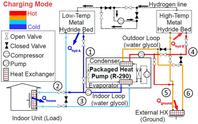Techno-economic analysis of metal-hydride energy storage to enable year-round load-shifting for residential heat pumps
Techno-economic analysis of metal-hydride energy storage to enable year-round load-shifting for residential heat pumps
| Authors: | P. Krane, D. Ziviani, J.E. Braun, N. Jain, and A. Marconnet |
|---|---|
| Journal: | Energy & Buildings |
| Paper URL: | Link to Full Text |
Thermal energy storage (TES), such as ice storage, is often used with air conditioning systems to shift cooling loads away from peak hours, reducing operating costs if time-of-use electricity rates are available. Phase change materials (PCMs) have been investigated for energy storage with heating systems; however, a single PCM cannot be used for storage with both cooling and heating since PCMs have fixed phase-change temperatures. Thermochemical energy storage with metal hydrides can be used for this purpose since the reaction used to store energy depends on both temperature and pressure, allowing for variable-temperature storage. In this paper, we propose a novel TES system design using metal hydrides coupled to a heat pump for residential heating and cooling and present a system model. The model is used to analyze system performance and predict cost savings for year-round use in a residential building. This system is shown to be capable of shifting heating and cooling loads, but only achieves cost savings of $13/year at existing utility rates. The payback period of the system exceeds 35 years across a range of rates more favorable to energy storage, primarily due to the high cost of metal hydrides. Potential improvements to the system are discussed.

